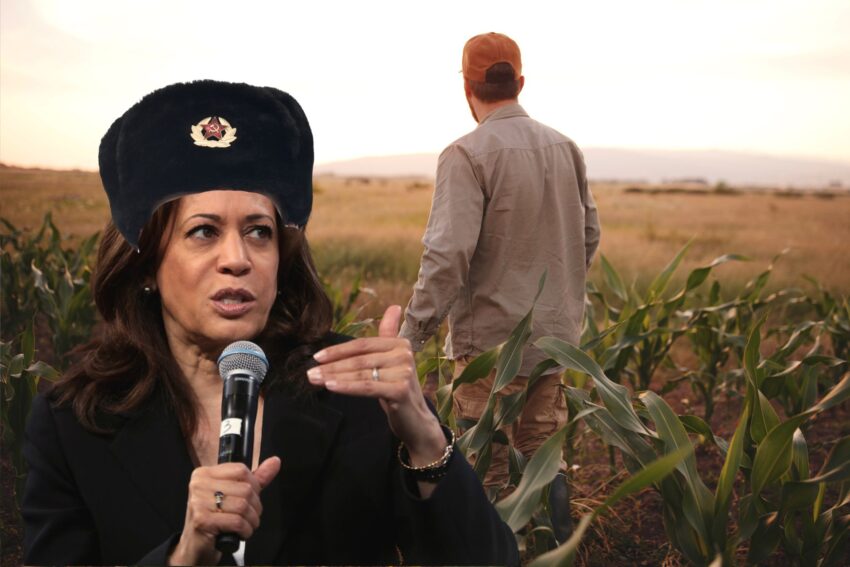No one likes seeing their grocery bills rise dramatically over just a few years. However, when politicians attempt to solve problems (that they often create), things can go from bad to worse. This is most certainly true with Kamala Harris’s new proposal to take on “greedy” grocery stores.
NEW: Kamala Harris openly brags about her price control policy that was called “communist” by the Washington Post.
“I will go after the bad actors and I will work to pass the first ever federal ban on price gouging on food.”
“My plan will include new penalties for opportunistic… pic.twitter.com/1z0q7wiZIe
— Collin Rugg (@CollinRugg) August 16, 2024
Kamala Harris’s recent proposal to ban what she terms “price gouging” in grocery stores has sparked a significant debate, not just on economic policy but also on its implications for farmers and the broader agricultural sector.
This move towards price controls is not without historical precedent, and those precedents are often cautionary tales, like what happened in the Soviet Union, Cuba, and Venezuela. In the Soviet Union, these controls resulted in widespread shortages because prices were set below market levels, leading to an imbalance where demand far exceeded supply. This created long lines for basic goods and fostered a thriving black market where goods could be sold at their actual market value, undermining the official economy. Following similar policies, Cuba experienced economic crises, particularly after the loss of Soviet subsidies, leading to what’s known as the “Special Period.” Here, price controls contributed to a dual currency system, which, while initially aimed at managing economic turmoil, eventually led to economic distortions, including the overvaluation of the Cuban peso and decreased competitiveness of domestic goods. Venezuela’s experiment with price controls in the 2000s, especially under Hugo Chávez, aimed at making food affordable but instead triggered hyperinflation, food shortages, and an economic collapse where over 75% of the economy was affected by 2021.
Generally, when prices are artificially capped below market rates, the incentive for producers to supply goods diminishes. Price controls lead to a reduction in the variety and quality of goods. Stores might opt for cheaper, lower-quality products to maintain profit margins, affecting consumer choice and health. This basic economic principle suggests that if grocery stores can’t charge what the market will bear, they might reduce stock or quality or, in extreme cases, close down, leading to food deserts. Most grocery stores, which have to pay rent, utilities, taxes, employees (managers, cashiers, stockers, deli workers, bakers, etc.), and other expenses, barely make a profit as is.
Grocery stores only had a 1.2% profit margin last year.
But Communist Kamala Harris says they’re price gouging.
Now Kamala wants to implement price controls to exacerbate the problem rather than address the inflation crisis her and Joe Biden created. pic.twitter.com/s4HjOAUeVJ
— Steve Cortes (@CortesSteve) August 16, 2024
Then there are the farmers, who operate on razor-thin margins, often with less than 1% profit. If grocery stores are forced to lower prices, they might pressure suppliers, including farmers, to reduce their prices further. This could lead to:
Reduced Income: Farmers might receive even less for their produce, potentially below the cost of production, driving many out of business.
Decreased Production: With lower returns, farmers might scale back production or shift to less labor-intensive crops, reducing overall food supply.
Innovation Stagnation: The agricultural sector might see less investment in technology and innovation due to decreased profitability, slowing down advancements.
The policy overlooks the complex supply chain where each intermediary adds value. If supermarkets can’t pass on increased costs due to inflation or other factors, the entire chain feels the squeeze, not just the end consumer.
This policy represents an obvious overreach, with bureaucrats in Washington dictating local market prices, potentially leading to inefficiencies and corruption. While being pitched as a program to help consumers, the policy would inevitably backfire when it leads to visible shortages or quality drops. Public trust in government economic policies is already in the tubes and would inevitably erode even further.
“It’s hard to exaggerate how bad this policy is. It is, in all but name, a sweeping set of government-enforced price controls across every industry. Supply and demand would no longer determine prices or profit levels. Far-off Washington bureaucrats would.”https://t.co/oKZwzJQSyb
— Bianna Golodryga (@biannagolodryga) August 16, 2024
Donald Trump has come out to blame the inflationary price increases on the actions of the Biden-Harris administration and call Harris’s plan to fix this mess “Communist.”
President Trump SLAMS Kamala's proposed price controls as "communist":
"Grocery prices have skyrocketed. Cereals are up 26%, bread is up 24%, butter is up 37%. Baby formula is up 30%, flour is up 38%, and eggs are up 46%. And many items are up at much higher rates than that."… pic.twitter.com/qIt4j3JWul
— Charlie Kirk (@charliekirk11) August 15, 2024
Kamala Harris’s policy against price gouging risks creating more problems than it solves. This could be catastrophic for farmers already facing low commodity prices, leading to a decline in agricultural output and farm viability. The policy’s reliance on price controls ignores fundamental economic principles, creating a scenario where consumers and producers suffer. This critique isn’t just about economic theory, but the practical, real-world implications that could affect every American’s dinner table. The debate over this policy should consider not just immediate consumer relief but the long-term health of the agricultural sector and the broader economy.



Great article! Your discussion on price controls reminds me of how these measures often hurt more than help, especially when looking at past examples. Out of curiosity, do you think consumers are aware of the potential long-term impacts on farmers if such policies are enacted? It feels like there’s often a disconnect between policy intentions and outcomes. Thanks for shedding light on these economic nuances! Keep the insightful posts coming.